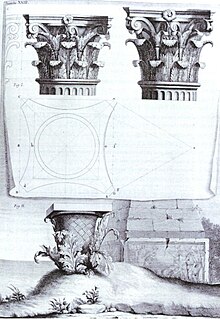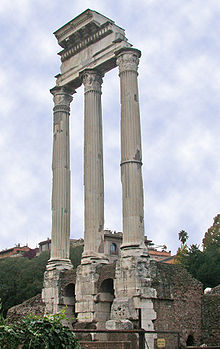Corinthian order
The Corinthian order is one of the five classical column orders . In the hierarchy of the column orders it takes the place between the Ionic and the composite order .
Building the Corinthian order
The classical Corinthian order is structured as follows:
base
The foundation and plinth of a Corinthian order building consist of the stereobat (foundation) and the Krepis (step substructure). The foundation is mainly in the ground and is only visible on the smoothed and semi-exposed top layer, the euthyntery . The foundation follows the Krepis with its three steps. The top step is called stylobate and serves as a base for the rising pillars.
pillar
The ionic fluted column shaft with 24 flutes rises on a composite or Attic base with plinth . The lower parts of the column shafts were sometimes facetted, and the fluting in the lower third was often filled with so-called pipe sticks. The shaft bears the Corinthian capital . The capital body, called Kalathos , is surrounded by two staggered wreaths of different heights, each made of eight stylized acanthus leaves . So-called caules develop from the corner leaves, each of which releases two plant stems of different strengths. The stronger stem, called the volute , grows towards the corner of the capitals , while the smaller stem, called the helix , turns towards the center of the respective face of the capital body. The volutes support the cover plate of the capital, the abacus , whose sides are concave. A rosette or abacus flower adorns the center of each of the four abacus sides.
Entablature
The entablature is made up of a three-fascia architrave and a smooth or sculpted frieze . After a pontic, which consists of a tooth section , a wave profile ( cyma reversa ) and egg rod , follows the console geison , above it a sima in the form of a cyma recta .
Historical development

The Corinthian order is the youngest of the three architectural styles of ancient Greek architecture . Its development began in historical times towards the end of the 5th century BC. With the "invention" of the Corinthian capital. Its canonical apparatus of forms, which turned the originally pure column order into a self-contained building code, was not binding until the middle of the 1st century BC. BC before. Therefore, the individual steps of their development can be easily followed.
The oldest preserved Corinthian capital is from the interior architecture of around 400 BC. To prove that the temple of Apollo was completed near Bassae . The use of the Corinthian capital was initially limited to interiors ( Tholos of Delphi , Tholos of Epidauros , temple of Athena Alea in Tegea ) and small architecture ( Lysikratesmonument - first appearance in external architecture, Ptolemaion in Samothrace , mausoleum of Belevi ).
The early examples of Corinthian columns were combined under Attic influence with Attic bases without a plinth, with Ionic architraves in various forms (two, three fasciae or smooth), with Ionic frieze (smooth or sculpted) and Ionic geison. From the Lysikrates monument, the canonical link is a tooth cut between frieze and geison.
By transferring the Corinthian column into the exterior architecture, it was first freed from its rigid connection to Ionic entablature forms. Often combinations with Doric beams are now used , but mostly reflect landscape preferences. In southern Italy there are also mixed forms with terracotta beams (Temple B in Pietrabbondante ).
Only in the late 3rd century BC The Corinthian capital found its way into the monumental temple architecture. However, it is proven and well dated that it only appears between 174 and 164 BC. At the Olympieion in Athens in the exterior architecture of a temple. It is also found in Italian temple architecture in the 2nd century BC. Entrance, as shown by the Corinthian-Doric forum temple in Paestum .
This temple once again proves the peculiarity of the Corinthian capital, depending on the landscape integration, that it can be combined with both an Ionic and a Doric entablature. The latter variant is found even in Augustan times, for example at the Augustus Temple of Philai in Egypt. Even for Vitruvius (4,1,1-3) the Corinthian order was still a pure column order, which could be connected with an Ionic or Doric entablature at will.
It was already around 100/90 BC. In Italy to connect the Corinthian order with the console geison as a new canonical element (Dioskurentempel in Cora ). As a result, the classical Corinthian order as defined above prevailed in central Italy, especially in Rome . We encounter it at almost all urban Roman temples of the late Republic and the early Principate such as the Temple of Apollo in circo or the Temple of Mars-Ultor , but also in the Roman provinces such as the Maison Carrée in Nîmes and many other buildings. In its combination of Attic, Asian Minor and Roman-Italic elements, the Corinthian order is one of the most important unifying forms of design in Roman imperial architecture.
The Corinthian order was preserved in its canonical formation until late antiquity . With the rediscovery of ancient architecture and the onset of Vitruvian reception in the Renaissance , the appreciation of the Corinthian order, which is correctly designed according to the model of Vitruvius, also begins again. The Corinthian order was used for magnificent buildings well into the 19th century.
Derivation of terms

Vitruvius (4,1,9-10) reports the following anecdote about the creation of the Corinthian capital: A virgin Corinthian fell ill and died. In mourning, her old nurse collected the toys, which the deceased had especially loved in her childhood, in a basket and placed it on the grave. So that things in the open air would not be damaged so quickly, the nurse places a stone plate on the basket to cover it. By chance the basket stood over an acanthus plant, the shoots of which grew up the sides of the basket. Callimachus , a painter and sculptor from the 5th century BC, saw this in passing . And was inspired by it to create the Corinthian capital.
The extent to which this story reflects the emergence of the Corinthian capital as a local Corinthian event ( apud Corinthios ) has not been clarified. A widespread interpretation leads the name back to the material from which the first such capitals are said to have been made: Corinthian bronze . Pliny in particular ( naturalis historia 34:13) is used to support this derivation. Pliny calls the porticus Octavia Corinthian in Rome because of its "brazen" capitals ( quae Corinthia sit appellata a capitulis aereis columnarum ). The Porticus Corinthia was named because of the material, but not because of the shape of its capitals. Philological references speak for a geographical derivation of the name, since as early as the 3rd century BC. In the Greek-Hellenistic cultural area the capital form is called korinthiourges . Word formations with - ourges always denote the local origin of a design.
Other ancient sources
- Callixeinos of Rhodes apud Athenaios 5,205c (= FGrHist 625 C 1, 38)
- Pausanias 8.45.4
- Strabon 4,4,6
See also
literature
- Heinrich Bauer : Corinthian capitals of the 4th and 3rd centuries BC BC (= Athenian communications. 3rd booklet). 1973.
- Pierre Gros : Aurea Templa. Research on l'architecture religieuse de Rome à l'époque d'Auguste. 1976.
- Wolf-Dieter Heilmeyer : Corinthian normal capitals (= Roman communications . 16. Supplementary booklet). 1970.
- Henner von Hesberg : Konsolengeisa of Hellenism and the early imperial period (= Roman communications. 24th supplement). 1980.
- Friedrich Rakob , Wolf-Dieter Heilmeyer: The round temple on the Tiber in Rome. 1973.
- Frank Rumscheid : Investigations into building ornamentation in Asia Minor. Volume I. 1994.
- Ralf Schenk: The Corinthian Temple until the end of the Augustus' Principle (= International Archeology. Volume 45). 1997, ISBN 978-3-89646-317-3 .
Web links
Individual evidence
- ↑ For Corinthian capitals from the classical, early Hellenistic and Roman times, see for example: Heinrich Bauer: Korinthische Kapitelle des 4. und 3. Century v. Chr. 3. Supplement Athenians releases, 1973; Friedrich Rakob, Wolf-Dieter Heilmeyer: The round temple on the Tiber in Rome. 1973, p. 23 ff .; Frank Rumscheid: Investigations into building ornamentation in Asia Minor. Vol. 1, 1994, passim and especially p. 309 f .; Wolf-Dieter Heilmeyer: Corinthian normal capitals (= Roman communications. 16. Supplementary booklet). 1970.
- ^ Maria José Strazzulla: Il santuario sannitico di Pietrabbondante. 1973, p. 23 ff.
- ↑ For italic-Corinthian capitals, see Heide Lauter-Bufe: The History of the Sicelotic-Corinthian Capital 1987.
- ↑ Friedrich Kraus, Reihard Herbig: The Corinthian Doric temple at the Forum of Paestum. 1939; Emanuele Greco , Dinu Theodorescu: Poseidonia - Paestum. Volume 3: Forum North. Ecole Française de Rome, Rome 1987, p. 30 ff.
- ↑ Heidi Hänlein-Schäfer: Veneratio Augusti. Bretschneider, Rome 1985, p. 191 ff.
- ↑ Paola Brandizzi Vittucci: Cora (= Forma Italiae . Regio I, Vol. V). De Luca, Rome 1968, p. 58 ff.
- ↑ Apollonios Rhodios frg. 1.7 P.
- ↑ For a discussion of the various points of view, see Ralf Schenk: On the description of the Korinthisches Kapitel. In: Archäologischer Anzeiger 1996, pp. 53–59.


